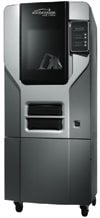![The Phrozen Sonic XL 4K [Source: Phrozen]](https://fabbaloo.com/wp-content/uploads/2020/05/image-asset_img_5eb067e11f71c.jpg)
The Phrozen Sonic XL 4K [Source: Phrozen]
I’m looking at the new Phrozen Sonic XL 4K 3D printer today.
This is a very intriguing device that has a high-resolution feature that I haven’t yet seen on many other desktop resin 3D printers.
Resin 3D Printer Principles
Let’s first understand how these machines work.
They are actually quite simple in concept: a tank of resin with a transparent bottom is placed over top of a standard LCD panel. To build each layer the LCD panel lights up, or at least the pixels corresponding to the solid portions of that particular layer light up, solidifying those parts per the design. Once a layer is solidified, the motion system raises up the platform and the process repeats.
This is the case for many low-cost resin 3D printers. In fact, many of the lower-cost models simply repurpose standard LCD panels designed for other applications in their equipment. Thus the number of pixels found on each LCD panel is usually a standard layout, like 1280 x 720 or 1920 x 1080 pixels.
The number of pixels represents the effective XY resolution of the device; the Z resolution is determined by the precision movement of the platform, not the pixel arrangement on the LCD panel.
Sonic XL 4K Resolution
Now here’s the interesting part of Phrozen’s new Sonic XL 4K: the LCD panel is actually a 4K pixel array. This means that the XY resolution of the device is a whopping 3840 x 2160 pixels. This has enabled Phrozen to expand the effective build volume of the Sonic XL without compromising resolution.
The build volume of the Sonic XL 4K is 120 x 190 x 200 mm. Those are almost the build volume dimensions of a small filament 3D printer. Typically resin machines offer vastly smaller 3D print build volumes, although they are typically used for applications such as jewelry or dental, which require small volumes but high resolutions.
The effective XY resolution of the machine is a fine 0.05mm, and the Z-axis resolution, or minimum layer size, is as small as 0.01mm.
Phrozen Sonic XL 4K Print Speed
Since each layer is produced all at once, the print speed of the Sonic XL 4K can be expressed as a vertical speed. In this case, Phrozen says the machine can print at a rate of 200mm vertical per hour, which is quite fast.
The speed is due to the “monochrome” LCD light engine design. This apparently transmits more energy more rapidly to the photopolymer resin and results in layer curing duration of only 0.2 seconds.
There’s another interesting feature: the backlight for the LCD panel is different from most other implementations. Usually a backlight is a single or multiple source light that is blocked from passing by the LCD panel’s pixels. The LCD, when instructed by the controller, can “open” a set of designated pixels for each layer. This simply allows the backlight to flow through.
However, in many LCD 3D printers the implementation does not have uniform flow of light for each pixel due to the distance between the pixel and the light. There’s a big difference in the Sonic XL 4K because they use a different backlight.
Instead of a few lights, they use an array of LEDs providing UV light. This provides a much more uniform flow of light for each pixel, and results in higher-quality prints. This is particularly true for larger prints that cover most of the build surface, something that would naturally happen with a large 3D printer such as the Sonic XL 4K.
The Sonic XL 4K looks like a very decent 3D printer that should produce high-quality — and large — 3D prints. From a few sources I’ve seen the device available for pre-order at a price of near US$2,300.
Via Phrozen

